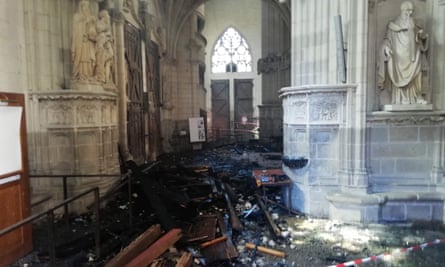
Nantes Cathedral fire
Nantes cathedral fire: a church volunteer admits to having started the fire

The remains of the organ in Nantes cathedral after the fire. Photograph: Fanny Andre / AFP / Getty
39-year-old man charged with arson after fire destroyed organ dating from 1621
A volunteer church assistant confessed to starting a fire that severely damaged a Gothic cathedral in Nantes, his lawyer said.
The 39-year-old asylum seeker from Rwanda who has lived in France for several years was arrested on Saturday after laboratory tests determined arson was the likely cause of the blaze, said the local prosecutor's office.
"My client cooperated," said the man's lawyer, Quentin Chabert, to the Presse-Océan newspaper on Sunday, without specifying the reasons for the attempt to burn down the cathedral of Saint-Pierre and Saint-Paul.
“He bitterly regrets his actions… My client is consumed with remorse,” said Chabert.
Prosecutors have opened an investigation into the arson at the Following the morning fire of July 18 , after noting that it had erupted in three different places of the church, which the volunteer had locked up the previous night.
He was interrogates the next day, then released without charge, the rector of the cathedral saying: “I trust him as I trust all the assistants.
But Nantes prosecutor Pierre Sennes said in a statement on Saturday that the man had been charged with "destruction and damage by fire", and faces up to 10 years in prison and € 150,000 (£ 136,000) fine.
"He admitted during his first appearance for questioning before the examining magistrate that he had lit three fires in the cathedral: at the main organ, at the smaller organ and at the electrical panel," Sennes said.
The blaze came 15 months after a devastating fire at the Notre- cathedral Lady from Paris , which raised questions about the security risks of other historic churches across France.
While firefighters were able to contain the Nantes blaze after just two hours and save its main structure, the organ, which dated from 1621 and had survived the French Revolution and World War II, was destroyed.
Priceless artifacts and paintings have also been lost, including a work by 19th-century artist Jean-Hippolyte Flandrin and stained-glass windows containing remains of 16th-century glass.
Work on the cathedral began in 1434 and continued until 1891. It was damaged by fire in 1972, after which concrete reinforcements were added during the repair of the roof.
The French government has said it will ensure the restoration of the cathedral. Philippe Charron, the head of the DRAC's regional heritage agency, said very few, if any, elements of the main body were likely to be saved.
"It will take several weeks to secure the site ... and several months of inspections which will be carried out stone by stone," he said. He added that the reconstruction would take several years.











Leave a comment